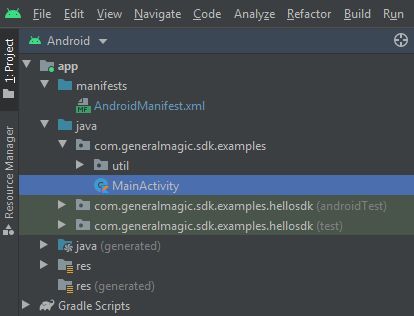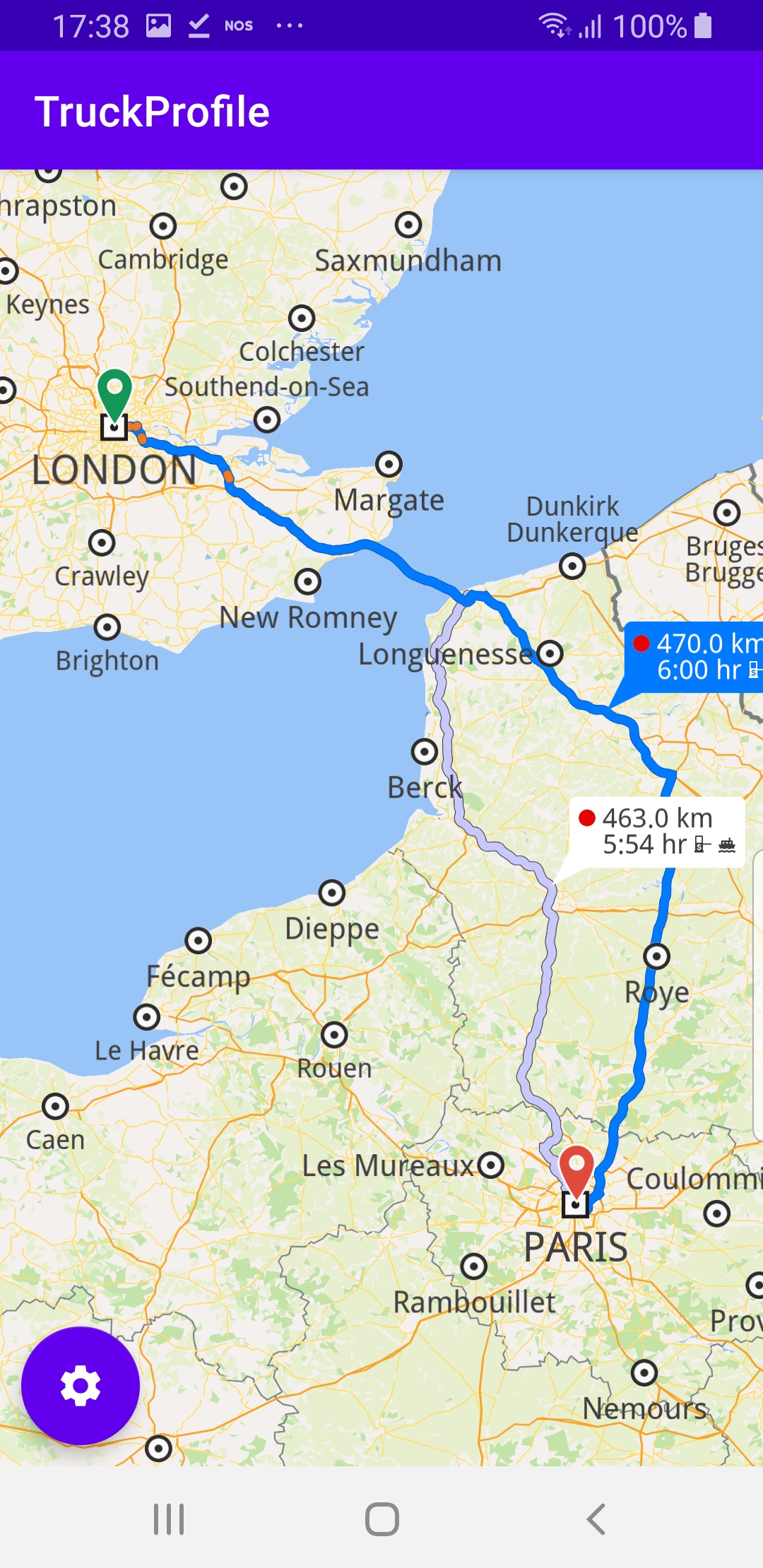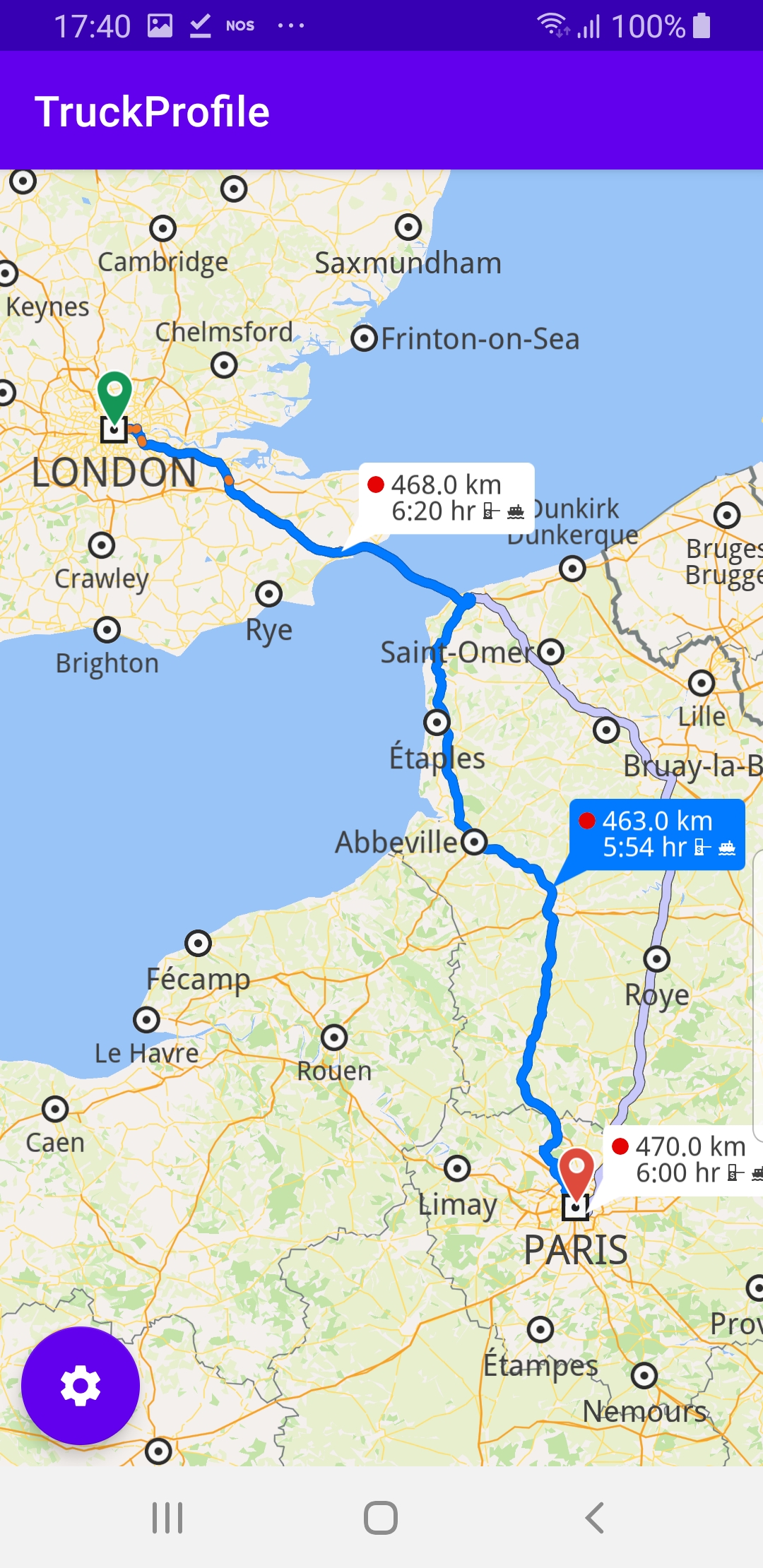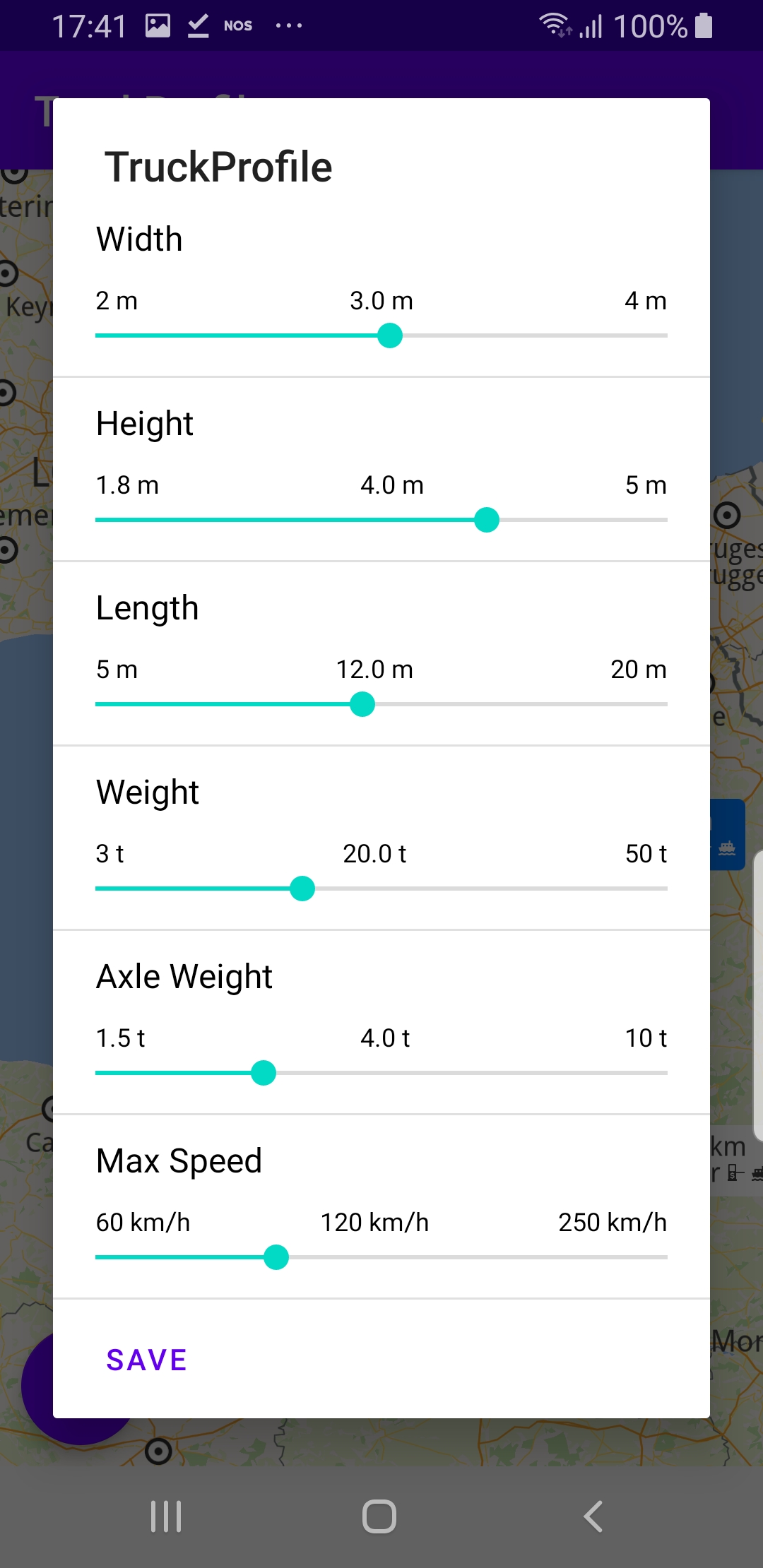Truck Profile ¶
Setup ¶
Download the
TruckProfile
project
archive file or clone the project with Git
See the Configure Android Example guide.
Run the example ¶
In Android Studio, from the
File
menu, select
Sync
Project
with
Gradle
Files
|
|
|
|
How it works ¶

1private val routingService = RoutingService(
2 onStarted = {
3 progressBar.visibility = View.VISIBLE
4 },
5 onCompleted = { routes, errorCode, _ ->
6 progressBar.visibility = View.GONE
7 when (errorCode)
8 {
9 GemError.NoError ->
10 {
11 routesList = routes
12 SdkCall.execute { gemSurfaceView.mapView?.presentRoutes(
13 routes = routes,
14 displayBubble = true
15 )
16 }
17 settingsButtons.visibility = View.VISIBLE
18 }
19 GemError.Cancel ->
20 {
21 showDialog("The routing action was canceled.")
22 }
23 else ->
24 {
25 // There was a problem at computing the routing operation.
26 showDialog("Routing service error: ${GemError.getMessage(errorCode)}")
27 }
28 }
29 }
30)
onStarted
and
onCompleted
routing callbacks are overridden and
implemented, to show, and then hide, respectively, the routing computation
progress bar, which is useful for very slow devices, where the route
computation may take long enough to be noticeable by the user.
gemSurfaceView.mapView?.presentRoutes()
1override fun onCreate(savedInstanceState: Bundle?)
2{
3 super.onCreate(savedInstanceState)
4 setContentView(R.layout.activity_main)
5 gemSurfaceView = findViewById(R.id.gem_surface_view)
6 progressBar = findViewById(R.id.progress_bar)
7 settingsButtons = findViewById<FloatingActionButton?>(R.id.settings_button).also {
8 it.setOnClickListener {
9 onSettingsButtonClicked()
10 }
11 }
12 SdkSettings.onMapDataReady = onMapDataReady@{ isReady ->
13 if (!isReady) return@onMapDataReady
14 // Defines an action that should be done when the world map is ready (Updated/ loaded).
15 SdkCall.execute {
16 waypoints = arrayListOf(
17 Landmark("London", 51.5073204, -0.1276475),
18 Landmark("Paris", 48.8566932, 2.3514616)
19 )
20 routingService.calculateRoute(waypoints)
21 }
22 gemSurfaceView.mapView?.onTouch = { xy ->
23 SdkCall.execute {
24 // tell the map view where the touch event happened
25 gemSurfaceView.mapView?.cursorScreenPosition = xy
26 // get the visible routes at the touch event point
27 val routes = gemSurfaceView.mapView?.cursorSelectionRoutes
28 // check if there is any route
29 if (!routes.isNullOrEmpty())
30 {
31 // set the touched route as the main route and center on it
32 val route = routes[0]
33 gemSurfaceView.mapView?.apply {
34 preferences?.routes?.mainRoute = route
35 centerOnRoutes(routesList)
36 }
37 }
38 }
39 }
40 }
41 SdkSettings.onApiTokenRejected = {
42 showDialog("TOKEN REJECTED")
43 }
44 if (!Util.isInternetConnected(this))
45 {
46 showDialog("You must be connected to the internet!")
47 }
48}
onCreate()
function is overridden in the
MainActivity:
AppCompatActivity()
class, and checks if
internet access is available, showing a dialog message if not.
findViewById()
is used to obtain pointers to the various
graphical user interface elements where text or graphical data
is to be displayed.
it.setOnClickListener
{
onSettingsButtonClicked()
}
onMapDataReady@{}
routingService.calculateRoute(waypoints)
Landmark
containing a name, a latitude,
in degrees, and a longitude, in degrees:
Landmark("Paris",
48.8566932,
2.3514616)
gemSurfaceView.mapView?.onTouch
=
{
xy
->
gemSurfaceView.mapView?.cursorSelectionRoutes
is used to see if the user touched one or more routes on
the map. If so, the first touched route (at index 0) is
selected and set as the main route, which causes it to
be drawn in dark blue on the map.
centerOnRoutes(routesList)
1private val adapter = TruckProfileSettingsAdapter(getInitialDataSet())
class
MainActivity
:
AppCompatActivity()
is
created to hold the truck dimensions and other attributes.
1private fun getInitialDataSet(): List<TruckProfileSettingsModel>
getInitialDataSet()
function sets the default initial
values in the form with the truck dimensions and other attributes
required for identifying a corresponding route between the
given departure and destination which is navigable by the
specified truck.
1private fun onSettingsButtonClicked()
2{
3 val builder = AlertDialog.Builder(this)
4 val convertView = layoutInflater.inflate(R.layout.truck_profile_settings_view, null)
5 val listView = convertView.findViewById<RecyclerView>(R.id.truck_profile_settings_list).apply
6 {
7 layoutManager = LinearLayoutManager(this@MainActivity)
8 addItemDecoration(DividerItemDecoration(applicationContext,
9 (layoutManager as LinearLayoutManager).orientation))
10 }
11 listView.adapter = adapter
12 builder.setTitle(getString(R.string.app_name))
13 builder.setView(convertView)
14 builder.setNeutralButton(getString(R.string.save)) { dialog, _ ->
15 onSaveButtonClicked()
16 dialog.dismiss()
17 }
18 val dialog = builder.create()
19 dialog.show()
20}
onSettingsButtonClicked()
function is called by the
listener defined in the
onCreate()
function above, when
the user clicks the industrial wheel settings button to
modify the truck profile attributes.
onSaveButtonClicked()
function to calculate the route
using the updated truck parameter values.
1private fun onSaveButtonClicked()
2{
3 val dataSet = adapter.dataSet
4 // convert m to cm
5 val width = (dataSet[ETruckProfileSettings.Width.ordinal].currentDoubleValue * 100).toInt()
6 val height = (dataSet[ETruckProfileSettings.Height.ordinal].currentDoubleValue * 100).toInt()
7 val length = (dataSet[ETruckProfileSettings.Length.ordinal].currentDoubleValue * 100).toInt()
8 // convert t to kg
9 val weight = (dataSet[ETruckProfileSettings.Weight.ordinal].currentDoubleValue * 1000).toInt()
10 val axleWeight = (dataSet[ETruckProfileSettings.AxleWeight.ordinal].currentDoubleValue * 1000).toInt()
11 // convert km/h to m/s
12 val maxSpeed = dataSet[ETruckProfileSettings.MaxSpeed.ordinal].currentIntValue * 0.27778
13 SdkCall.execute {
14 routingService.apply {
15 preferences.alternativesSchema = ERouteAlternativesSchema.Never
16 preferences.transportMode = ERouteTransportMode.Lorry
17 preferences.truckProfile = TruckProfile(
18 massKg = weight,
19 heightCm = height,
20 lengthCm = length,
21 widthCm = width,
22 axleLoadKg = axleWeight,
23 maxSpeedMs = maxSpeed
24 )
25 calculateRoute(waypoints)
26 }
27 }
28}
onSaveButtonClicked()
function sets the truck profile
attributes in the preferences and then calculates the route using
calculateRoute(waypoints)


